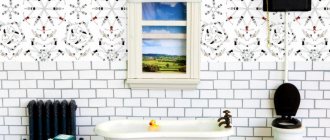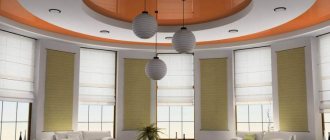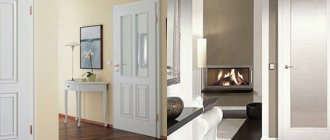The combination of tiles and laminate in the kitchen was to the taste of not only interior designers, but also apartment owners. This design idea visually divides the space into several zones and makes it easier to care for the flooring.
When preparing a kitchen renovation, one of the most important tasks is choosing a practical flooring material.
What are the features of the combination of tiles and laminate, and is it worth starting renovations in the kitchen without using the usual linoleum?
In most cases, laminate and ceramic tiles are used.
Combined kitchen floor
The kitchen is a functional area in the living space, which is visited by all household members. Here they create culinary masterpieces, drink another cup of invigorating coffee and gather at the dinner table with the whole family. The kitchen is used as both a work area and a relaxation area. While something is “crackling” and cooking on the stove, adults exchange news of their day, and the children secretly feed their beloved dog under the table.
In recent years, these types of cladding are quite often combined in one space.
Before you start renovating your kitchen, think: how much time will the housewife spend scrubbing off the next greasy stain? Yes, there’s no way without it. The work area around the stove and sink is especially susceptible to culinary “cataclysms.” Here everything tends to spill, wake up and stain the floor.
One of the leading trends in interior design in a private house or apartment is the installation of combined floors.
Therefore, the more practical you choose a floor covering, the less time and effort it will take to clean.
Using a combined floor in the kitchen, you will kill two birds with one stone: create a cozy atmosphere for relaxation and a comfortable area for preparing food. The combination of tiles and laminate is appropriate in any kitchen with a total area of over 6 m2.
These coatings satisfy all requirements for floor coverings.
In small rooms, the tiled floor will look like a kitchen apron, and in studio kitchens it will look like two separate areas (working and dining).
They are easy to clean from dirt and have a presentable appearance.
Basic requirements for materials
The tiles in the kitchen are classics of the genre. But designers are wary of laminate and cannot recommend every model for a kitchen interior.
Any floor covering must meet a simple set of requirements.
- Easy to wash.
- Withstand impacts from falling dishes.
- Be wear-resistant.
- Tolerate exposure to aggressive household chemicals.
- Do not absorb odors.
- Maintain an attractive appearance after contact with water.
Therefore, the laminate must be selected not only according to color, but also according to the degree of moisture resistance. At the same time, consider how far the area with the laminate floor is from the sink and stove.
Tips for choosing materials for a combined floor
Proper selection of materials is the key to a long service life. There are a number of requirements for flooring:
- easy to clean;
- resistant to abrasion, moisture and household chemicals;
- does not absorb odors.
They are resistant to mechanical damage, for example, to impacts from breaking dishes.
Based on the purpose of the kitchen, fire-resistant materials are chosen that can withstand high traffic and mechanical damage, have a moisture-resistant coating or an additional layer of waterproofing. Tile is suitable for the working area, laminate for the dining area. The connecting seam is made in the form of a straight or winding line.
Modern materials are resistant to severe abrasion.
Choosing a laminate
A laminate with a non-slip surface, classified as waterproof, is suitable for the kitchen. Give preference to the imperishable classics - matte lamellas with a design like “natural wood” or “parquet” laminate. The wear resistance class must be at least 32. There are no marks left on the matte laminate, it more clearly imitates the pattern of natural wood, is more practical and easy to maintain than its glossy counterpart. In operation it has proven to be a safe and durable material.
They can withstand the effects of household chemicals without damaging their appearance.
Important! Pay attention to the markings. Choose E-1 laminate, which contains a minimum amount of formaldehyde.
Tile-like kitchen laminate flooring is an alternative to standard tiles. It imitates the pattern of marble, granite or terracotta tiles. The material is highly moisture resistant and suitable for use in the dining area. There are models with an antistatic effect, which makes cleaning the kitchen easier. This option is suitable for non-standard interior solutions.
The materials retain their technical and operational properties with frequent contact with liquid media.
Choosing a tile
Kitchen floor tiles are produced by pressing or “extrusion”. The manufacturing method directly affects the performance characteristics of the material. Suitable for working area flooring:
- tiles for “parquet” or “wooden board”;
- ceramic tile;
- porcelain stoneware;
- floor tiles.
Laminate and tile look perfect together, especially if you choose them correctly in color and texture.
Vinyl tiles are rarely used for flooring.
Tile selection criteria:
- wear resistance on the PEI scale;
- water absorption class;
- acid resistance marking,
- alkalis and other chemicals;
- texture, relief, design.
This combination looks optimal in studios, as well as combined rooms that perform several functions simultaneously - kitchen + living room or kitchen + dining room.
Give preference to floor tiles of class PEI III or PEI IV, with moisture absorption coefficient II, marked AA. The surface texture should be rough. Choose structured or embossed models, which are characterized by an anti-slip effect and imitation of natural textures (stone, wood, leather, etc.). Before purchasing, inquire about the friction coefficient and water resistance rating. The first must be no lower than 0.75%, and the second no higher than 3%.
In residential buildings with a standard layout, such solutions can be quite successful.
Note! The packaging may be marked with the letter "A" or "B". The first says that the production technology was extrusion, and the second - pressing.
The combination of tiles and laminate is done taking into account the color scheme, texture and general design style. To reduce visual noise, it is necessary to combine materials of different shades of the same color. The tile should be a tone lighter than the laminate, or vice versa.
By combining these materials, you can save on consumables without compromising the attractive appearance of the room.
To zone a space using colors, pay attention to the dimensions of the room and lighting. Visually expand the area with light colors and narrow it with dark shades. The same principle applies to light balance. For a well-lit area, choose a cool color, for a darkened area, shades of a warm palette.
The best option would be a light brown or noble gray color.
Important! Do not use white or black materials. They are too easily soiled and labor-intensive to care for.
Don't forget about the size of the tiles and lamellas. Large tiles look beautiful in spacious rooms, and small tiles look beautiful in small rooms.
Typically, tile coverings are laid in the work area - that is, where food is cut and prepared.
Ideas for combining flooring in the kitchen
The combination of materials must be thought out before starting work, so that, taking into account the difference in thickness, a difference of the required magnitude can be made on the floor (during its preparation).
Tiles and laminate
These materials are perfectly combined in thickness and physical characteristics. Laminate flooring for the kitchen is selected with the highest degree of strength and moisture resistance. No matter how beautiful the glossy finish is, preference should be given to the option with a matte surface. It is easier to care for, and its textured structure will prevent it from slipping even on a wet floor. Laminate is not indifferent to moisture and grease, which is why it is used in the dining area.
Ceramic tiles are best suited for finishing the floor near the workplace. But not a slippery glossy one, but a matte one with a textured structure. There are so many colors and textures in the assortment that it will not be difficult to choose the ones that suit your kitchen decor. The combination of tiles and laminate with images of marble, limestone, oak, and beech looks impressive.
Tiles and linoleum
Ease of installation and low price have made linoleum popular for several decades. It is moisture-resistant, soft, silent, and can withstand cleaning agents without loss of appearance. A large selection of colors allows for a successful combination with other floor coverings, including tiles. Linoleum looks beautiful with an imitation of wooden or parquet flooring. The anti-slip coating improves grip on shoes, and a minimal number of joints makes the floor easier to clean.
Test results showed that the artificial material is no worse than natural linoleum in all respects, but costs less.
Linoleum and laminate
These materials complement each other perfectly, since service life, heat transfer, hygienic parameters and price differ slightly. If you choose linoleum with an imitation of a luxurious carpet, you can lay it in the recreation area. However, it is better to use it near the workplace, since it is not as picky about moisture as laminate, which will allow you to walk in the dining area even barefoot.
Tiles and parquet boards
These materials are not often used for combination, but in vain. Using parquet boards you can make your kitchen interior chic and comfortable. Valuable wood species are used for production.
Parquet boards are easy to install, but they are easily scratched and do not withstand moisture and detergents, so frequent washing is not recommended. However, in a dining area where there are no negative factors, it will look great, since no coating can compare with the warmth of natural wood.
Porcelain tiles and laminate
The combination of these materials will ensure the strength, durability and beauty of your kitchen floor. In terms of characteristics, porcelain tiles are similar to earthenware tiles, but have higher strength and can withstand even strong impacts. Its service life is indicated not in decades, but in centuries. Even the most aggressive detergents, much less water and grease, do not affect porcelain tiles. Therefore, it is ideal for the work area. Selecting the right shade when combined with laminate will not cause any difficulties, since there are any options in the color palette. They are approximately the same in thickness, which will make joining easier.
Porcelain tiles with a polished surface are not suitable for the kitchen, since they become slippery after liquid gets on them. Matte tiles do not have this defect, they do not lend themselves to abrasion and are easy to clean.
When purchasing, you need to pay attention to the presence of small technical holes on the back side. Their shape should be smooth and neat.
Advantages and disadvantages
Advantages of combined flooring in the kitchen:
- the opportunity to implement a fashionable design project;
- interesting color solutions;
- variety of shapes, sizes, patterns of finishing materials.
The tile has a fairly dense structure, due to which it does not absorb organic acids, various dyes and all kinds of odors.
Zoning the space allows you to double the service life of the flooring through the use of durable materials. Although the work area always gets dirty quickly, it is easier to clean if it is covered with tiles.
For a large and spacious kitchen, medium-sized tiles are traditionally used, less often - large panels.
With the help of laminate, the space visually changes. In studio apartments, they often combine the kitchen and living room. By using the same laminate flooring in the living and dining areas, you can expand the space.
The thermal sensation of the coating is also important, namely how the inhabitants of the house perceive it - cold or warm.
The disadvantage is the coldness of the tile covering, which can be eliminated by installing a heated floor system. Otherwise, the combined floor has the same pros and cons that are characteristic of tiles and laminate.
In the recreation area, it is better to lay laminate flooring, which provides a comfortable feeling of warmth.
Where to join tiles and laminate in the kitchen
Most often, tile covering is planned as an addition to the work area near the countertop. In this case, the width of the tile path is taken equal to 1.5 steps of an adult. This is enough to move freely along the furniture in the kitchen and not step on the protective lining along the edge of the laminate.
There is always more laminate in the kitchen than tiles
A narrower tile layout is not always convenient, especially if two or three people are at the stove in the kitchen at the same time. It makes no sense to build a wider strip, more than a meter wide, and besides, tile is not the most comfortable surface; it is much more pleasant to move on laminate than on slippery tiles.
How to combine tiles and laminate?
Both materials will become an integral part of the interior. With their help you can enhance or highlight the decorative effect. A tiled island in the kitchen requires special attention. Since it is adjacent to household appliances and kitchen units, it should complement them and emphasize small decorative details.
The golden rule for decorating a kitchen space is as follows: the smaller the free kitchen area, the more concise and simple the decor should be.
The joint at the border of the laminate and tiles is of no small importance. More often than not, it becomes a stumbling block. Many people do not know how to make a combined floor in the kitchen from tiles and laminate so that the seam is invisible. Ideally, there should be no junction. In this case, the floor looks like a solid canvas of two different colors.
Laminate and porcelain tiles create a discreet but stylish coating.
There are several options for laying tiles and laminates, in which the border is laid out as follows:
- straight line;
- broken arc;
- semicircles;
- another.
The type of joint is chosen by the owners based on their preferences and the usual “trajectory” of movement around the kitchen. The border divides the room into equal parts or islands in the proportion of 1/3, where one third is allocated to the work area, and two to the dining area. To get fancy zone outlines, use hexagonal tiles in the shape of a honeycomb.
The materials balance each other and emphasize the taste and impeccable style of the owners of the residential building.
Hallway floor
The use of combined tile and laminate floors in the hallway plays a practical role. Usually the tiles are placed near the front door, where you are supposed to take off your shoes before entering the apartment.
How to choose the color of tiles for the floor? In the hallway, it is recommended to use tiles with a pattern that imitates parquet, wood or stone. Both laminate and floor tiles should be in the same tone. It is necessary to select two colors so that the entire composition looks like a single whole.
Two more options for selecting floor coverings
A contrasting solution is acceptable in large, spacious corridors. The tiles can be matte, glossy or embossed. It is important that small scratches that occur when removing shoes are not visible on it and that dirt that has fallen from the soles is easily removed.
After taking off your shoes on the tiled platform, you can immediately step onto the laminate floor. Unlike cold tiles, it is warm and soft to the touch, and it is pleasant to walk on it with bare feet.
How to make a smooth transition between tiles and laminate?
The main problem of the joint is that it is impossible to do without a gap. A small gap must be left to compensate for the thermal expansion of the two different materials. Under no circumstances should the seam be filled with cement mortar or resin to avoid warping of the laminate.
In kitchens with high ceilings, you can give preference to dark coatings.
The joint is made in the form of a threshold or overhead elements made of aluminum or vinyl. If the kitchen design does not require this, then use a cork gasket or grout the seam with colored silicone with the preliminary installation of an L-shaped metal strip.
Conclusion
The combination of tiles and laminate has become a universal and most practical option for flooring. At first the hallway saw this type of finish, but soon the two materials began to be combined for kitchen renovations. Dividing the area helps to rationally use space and allows you to create an original design.
The combination of ceramics and lamellas improves the performance of the flooring.
Flooring requirements
The idea of combining two different materials in a floor covering did not come out of nowhere. It is based on the desire to find an option that will optimally satisfy all the flooring quality requirements for kitchen premises. Factors affecting kitchen floors impose strict requirements:
- The floor should not be slippery (neither dry nor wet). If wet tiles are so slippery that you can fall on them, then they are not suitable for the kitchen.
- Any stains should be easily removed from the coating . Water, fruit and meat juice, grease and other contaminants should be easily cleaned off using water or household detergents.
- Resistance to loads without changing appearance . The coating is affected by the feet of residents, furniture legs, falling objects, friction during cleaning, and cleaning solutions. An ideal material should successfully resist destruction for at least 5-6 years.
- Aesthetic qualities. The flooring should harmonize well with interiors designed in different styles.
Important ! Sanitary qualities are also important. The coating should not develop mold, bacterial colonies or other pathogenic organisms.
It is incredibly difficult to combine such different qualities in one type of flooring. Therefore, the idea arose to combine the advantages of tiles and laminate, placing them in those areas of the kitchen where the properties of these coatings will manifest themselves best.
Combination options
Since both coatings have their own pattern, color and texture, it is important to correctly determine what will play the role of a background and what will be the main detail of the interior. Most designers agree that the emphasis should be on tiles. There is usually less of it in the kitchen; in addition, it is placed next to the set, which helps highlight its aesthetic qualities.
Scheme of dividing the kitchen room with a joint line
The seam line is the most important place on the floor. Neither your foot should catch on the joint when walking, nor your eye when examining it. Then the combination will look as successful as possible. Here are the most common options:
- Straight line. The easiest option to organize. Unfortunately, it usually looks the most unnatural.
- Separation of zones by a straight line, taking into account the overall geometry of the kitchen. Then one of the zones is organized “in a pocket”, and the alignment line emphasizes this border.
- Curved lines look impressive and allow you to divide the space optimally.
Advice ! To determine the boundaries of zones, use marks on old linoleum or other type of covering. They, like a map, will show where more protection is needed and where the most passable paths through the kitchen are.
If the tile has a complex shape (for example, a hexagonal honeycomb), the dividing line may be broken.
Contrasting combination of tiles and laminate
The use of tiles and laminate in contrasting colors allows you to clearly define the boundaries between zones. In this case, the tiles are usually chosen lighter, and the laminate – darker. Then the light area next to the work surface will naturally be perceived as the hostess’s territory, and the rest of the space as an area for guests.
Advice ! When using one color, a sense of contrast between zones can be achieved by changing the direction of laying the flooring. Then the laminate will go at an angle or perpendicular to the tile.
How to combine flooring with furniture?
Combining flooring colors with furniture shades is another technique for creating a unified interior. It’s easiest with light-colored furniture: it looks good with any tile, and the contrasting laminate should have a dark or red-brown tint.
Dark furniture is more difficult to work with. Here you will have to create color patterns. Then the dark shades of the furniture façade and laminate will blend into each other, combining with the light shades of the apron and tiled covering.











